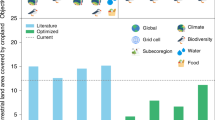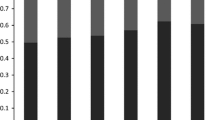Abstract
Context
Expansion of bioenergy production is part of a global effort to reduce greenhouse gas emissions and mitigate climate change. Dedicated biomass crops will compete with other land uses as most high quality arable land is already used for agriculture, urban development, and biodiversity conservation.
Objective
First, we explore the trade-offs between converting land enrolled in the U.S. Conservation Reserve Program (CRP) to switchgrass for biofuel production or preserving it for biodiversity. Next, we examine the trade-offs between agriculture, biodiversity, and biofuel across the central and eastern U.S.
Methods
We compiled measures of biodiversity, agriculture, and biofuel from land cover classifications, species range maps, and mechanistic model output of switchgrass yield. We used a spatially-explicit optimization algorithm to analyze the impacts of small-to-large scale biomass production by identifying locations that maximize biofuel produced from switchgrass and minimize negative impacts on biodiversity and agriculture.
Results
Using CRP land for switchgrass production increases the land area required to meet biomass goals and the species range area altered for birds, amphibians, mammals, and reptiles. When conversion is not limited to CRP, conversion scenarios including biodiversity and agriculture trade-offs require greater than 100 % more area for switchgrass to reach the same production goals. When land conversion scenarios do not include biodiversity, twice the range area for reptiles and amphibians could be altered.
Conclusions
Land-use trade-offs between biofuel production, agriculture, and biodiversity exist and alter optimum location of land conversion for low-to-high biofuel levels. This highlights the need for systematic land-use planning for the future.




Similar content being viewed by others
References
Altieri MA (2009) The ecological impacts of large-scale agrofuel monoculture production systems in the Americans. Bull Sci Technol Soc 29(3):236–244
Asner GP, Elmore AJ, Olander LP, Martin RE, Harris AT (2004) Grazing systems, ecosystem responses, and global change. Annu Rev Environ Resour 29(1):261–299
Behrman KD, Kiniry JR, Winchell M, Juenger TE, Keitt TH (2013) Spatial forecasting of switchgrass productivity under current and future climate change scenarios. Ecol Appl 23(1):73–85
BirdLife International, NatureServe (2012) Bird species distribution maps of the world. Version 2.0. BirdLife International, Cambridge, UK and NatureServe, Arlington
Brooks TM, Mittermeier RA, Da Fonseca GAB, Gerlach J, Hoffmann M, Lamoreux JF, Mittermeier CG, Pilgrim JD, Rodrigues ASL (2006) Global biodiversity conservation priorities. Science 313(5783):58–61
Casler MD, Vogel KP, Taliaferro CM, Wynia RL (2004) Latitudinal adaptation of switchgrass populations. Crop Sci 44:293–303
Chapin FS, Walker BH, Hobbs RJ, Hooper DU, Lawton JH, Sala OE, Tilman D (1997) Biotic control over the functioning of ecosystems. Science 277(5325):500–504
Ciarleglio M, Wesley Barnes J, Sarkar S (2009) ConsNet: new software for the selection of conservation area networks with spatial and multicriteria analyses. Ecography 32(2):205–209
Dale VH, Kline KL, Wright LL, Perlack RD, Downing M, Graham RL (2011) Interactions among bioenergy feedstock choices, landscape dynamics, and land use. Ecol Appl 21(4):1039–1054
Danielsen F, Beukema H, Burgess ND, Parish F, Brühl CA, Donald PF, Murdiyarso D, Phalan B, Reijnders L, Struebig M, Fitzherbert EB (2008) Biofuel plantations on forested lands: double jeopardy for biodiversity and climate. Conserv Biol 23(2):348–358
Davis S, Parton W, Dohleman F, Smith CM, Grosso SD, Kent AD, DeLucia EH (2010) Comparative biogeochemical cycles of bioenergy crops reveal nitrogen-fixation and low greenhouse gas emissions in a Miscanthus giganteus agro-ecosystem. Ecosystems 13(1):144–156
Dobson AP, Rodriguez JP, Roberts WM, Wilcove DS (1997) Geographic distribution of endangered species in the United States. Science 275(5299):550–553
Fargione JE, Hill JD, Tilman D, Polasky S, Hawthorne P (2008) Land clearing and the biofuel carbon debt. Science 319(5867):1235–1238
Fargione JE, Plevin RJ, Hill JD (2010) The ecological impact of biofuels. Annu Rev Ecol Evol Syst 41(1):351–377
Farm Services Agency (2008) Farm Bill 2008. Farm Services Agency, Washington DC
Farm Services Agency (2012) Conservation Reserve Program. Farm Services Agency, Washington DC
Foley JA, Defries R, Asner GP, Barford C, Bonan G, Carpenter SR, Chapin FS, Coe MT, Daily GC, Gibbs HK, Helkowski JH, Holloway T, Howard EA, Kucharik CJ, Monfreda C, Patz JA, Prentice IC, Ramankutty N, Snyder PK (2005) Global consequences of land use. Science 309(5734):570–574
Foley JA, Ramankutty N, Brauman KA, Cassidy ES, Gerber JS, Johnston M, Mueller ND, O’Connell C, Ray DK, West PC, Balzer C, Bennett EM, Carpenter SR, Hill J, Monfreda C, Polasky S, Rockström J, Sheehan J, Siebert S, Tilman D, Zaks DP (2011) Solutions for a cultivated planet. Nature 478(7369):337–342
Herkert JR (2007) Conservation reserve program benefits on Henslow’s sparrows within the United States. J Wildl Manag 71(8):2749–2751
Hooper DU, Chapin FS III, Ewel JJ, Hector A, Inchausti P, Lavorel S, Lawton JH, Lodge DM, Loreau M, Naeem S, Schmid B, Setälä H, Symstad AJ, Vandermeer J, Wardle DA (2005) Effects of biodiversity on ecosystem functioning: a consensus of current knowledge. Ecol Monogr 75(1):3–35
Homer CG, Dewitz JA, Yang L, Jin S, Danielson P, Xian G, Coulston J, Herold ND, Wickham JD, Megown K (2015) Completion of the 2011 National Land Cover Database for the conterminous United States-Representing a decade of land cover change information. Photogramm Eng Remote Sens 81(5):345–354
IEA (2006) World energy outlook 2006. Organisation for economic co-operation and development, Paris
IEA (2013) World energy outlook 2013. Organisation for Economic Co-operation and Development, Paris
IUNC (2012) IUNC Red List of Threatened Species Version 2012.1
Johnson R, Becker GS (2008) The 2008 Farm Bill: major provisions and legislative action. Congressional Research Service, Library of Congress
Kyoto Protocol (2009) United Nations Framework Convention on Climate Change
McLaughlin SB, Walsh ME (1998) Evaluating environmental consequences of producing herbaceous crops for bioenergy. Biomass Bioenergy 14(4):317–324
McLaughlin SB, Kiniry JR, Taliaferro CM, DeLaTorreUgarte D (2006) Projecting yield and utilization potential of switchgrass as an energy crop. In: Donald LS (ed) Advances in agronomy. Academic Press, London, pp 267–297
Meehan TD, Hurlbert AH, Gratton C (2010) Bird communities in future bioenergy landscapes of the Upper Midwest. Proc Natl Acad Sci 107(43):18533–18538
Mitchell R, Vogel KP, Uden DR (2012) The feasibility of switchgrass for biofuel production. Biofuels 3(1):47–59
Parmesan C (2006) Ecological and evolutionary responses to recent climate change. Annu Rev Ecol Evol Syst 37:637–669
Perlack RD, Wright LL, Turhollow AF, Graham RL, Stokes BJ, Erbach DC (2005) Biomass as feedstock for a bioenergy and bioproducts industry: the technical feasibility of a billion-ton annual supply, ORNL/TM-2005/66, DOE/GO-102005-2135
Pimentel D, Marklein A, Toth MA, Karpoff M, Paul GS, McCormack R, Kyriazis J, Krueger T (2008) Biofuel impacts on world food supply: use of fossil fuel. Land Water Resour Energy 1(2):41–78
Raghu S, Spencer JL, Davis AS, Wiedenmann RN (2011) Ecological considerations in the sustainable development of terrestrial biofuel crops. Curr Opin Environ Sustain 3(1–2):15–23
Renewable and Application Energy Laboratory (2007) Energy and resources group biofuels analysis meta-model. University of California, Berkley
Renewable Fuels Agency (2008) The Gallagher review of the indirect effects of biofuels production. Renewable Fuels Agency, London
Reynolds RE, Shaffer TL, Loesch CR, Cox RR (2006) The farm bill and duck production in the prairie pothole region: increasing the benefits. Wildl Soc Bull 34(4):963–974
Robertson BA, Doran PJ, Loomis ER, Robertson JR, Schemske DW (2011a) Avian use of perennial biomass feedstocks as post-breeding and migratory stopover habitat. PLoS One 6(3):16941
Robertson BA, Doran PJ, Loomis LR, Robertson JR, Schemske DW (2011b) Perennial biomass feedstocks enhance avian diversity. GCB Bioenergy 3(3):235–246
Robertson G, Hamilton S, Del Grosso S, Parton W (2011c) The biogeochemistry of bioenergy landscapes: carbon, nitrogen, and water considerations. Ecol Appl 21:1055–1067
Rockström J, Steffen W, Noone K, Persson A, Chapin FS 3rd, Lambin EF, Lenton TM, Scheffer M, Folke C, Schellnhuber HJ, Nykvist B, de Wit CA, Hughes T, van der Leeuw S, Rodhe H, Sörlin S, Snyder PK, Costanza R, Svedin U, Falkenmark M, Karlberg L, Corell RW, Fabry VJ, Hansen J, Walker B, Liverman D, Richardson K, Crutzen P, Foley JA (2009) A safe operating space for humanity. Nature 461(7263):472–475
Sala OE, Chapin FS 3rd, Armesto JJ, Berlow E, Bloomfield J, Dirzo R, Huber-Sanwald E, Huenneke LF, Jackson RB, Kinzig A, Leemans R, Lodge DM, Mooney HA, Oesterheld M, Poff NL, Sykes MT, Walker BH, Walker M, Wall DH (2000) Global biodiversity scenarios for the year 2100. Science 287(5459):1770–1774
Sanderson MA, Reed RL, McLaughlin SB, Wullschleger SD, Conger BV, Parrish DJ, Wolf DD, Taliaferro C, Hopkins AA, Ocumpaugh WR, Hussey MA, Read JC, Tischler CR (1996) Switchgrass as a sustainable bioenergy crop. Bioresour Technol 56(1):83–93
Schmer MR, Vogel KP, Mitchell RB, Perrin RK (2008) Net energy of cellulosic ethanol from switchgrass. Proc Natl Acad Sci 105(2):464–469
Searchinger T, Heimlich R, Houghton RA, Dong F, Elobeid A, Fabiosa J, Tokgoz S, Hayes D, Yu TH (2008) Use of U.S. croplands for biofuels increases greenhouse gases through emissions from land-use change. Science 319(5867):1238–1240
Thomas CD, Cameron A, Green RE, Bakkenes M, Beaumont LJ, Collingham YC, Erasmus BF, De Siqueira MF, Grainger A, Hannah L, Hughes L, Huntley B, Van Jaarsveld AS, Midgley GF, Miles L, Ortega-Huerta MA, Peterson AT, Phillips OL, Williams SE (2004) Extinction risk from climate change. Nature 427(6970):145–148
Tilman D, Knops J, Wedin D, Reich P, Ritchie M, Siemann E (1997) The influence of functional diversity and composition on ecosystem processes. Science 277(5330):1300–1302
Tilman D, Socolow R, Foley JA, Hill J, Larson E, Lynd L (2009) Beneficial biofuels—the food, energy, and environment trilemma. Science 325(5938):270–271
Towards a Thematic Strategy on Soil Protection: Communication from the Commission of the Council (2002) The Economic and Social Committee and the Committee of the Regions, Brussels
U.S. Congress (2007) Energy Independence and Security Act of 2007. http://www.GovTrack.us
U.S. Department of Energy (2011) U.S. billion-ton update: biomass supply for a bioenergy and bioproducts industry. RD Perlack and BJ Stokes (Leads), ORNL/TM-2011/224. Oak Ridge National Laboratory, Oak Ridge, TN. 227p
Wang D, Lebauer DS, Dietze MC (2010) A quantitative review comparing the yield of switchgrass in monocultures and mixtures in relation to climate and management factors. GCB Bioenergy 2(1):16–25
Acknowledgments
We thank Daren Harmel, Mari-Vaughn Johnson, Norman Meki, and Wayne Polley for helpful comments. Funding for this works was provided by The National Science Foundation Plant Genome Research Program award number NSF IOS-0922457. USDA is an equal opportunity provider and employer.
Author information
Authors and Affiliations
Corresponding author
Electronic supplementary material
Below is the link to the electronic supplementary material.
Rights and permissions
About this article
Cite this article
Behrman, K.D., Juenger, T.E., Kiniry, J.R. et al. Spatial land use trade-offs for maintenance of biodiversity, biofuel, and agriculture. Landscape Ecol 30, 1987–1999 (2015). https://doi.org/10.1007/s10980-015-0225-1
Received:
Accepted:
Published:
Issue Date:
DOI: https://doi.org/10.1007/s10980-015-0225-1




